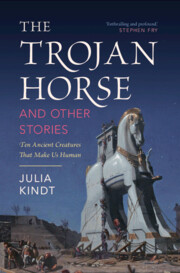Refine search
Actions for selected content:
52 results
7 - Human Rights and One Health
- from Part II - One Health and Contemporary Legal Structures
-
-
- Book:
- The Cambridge Handbook of One Health and the Law
- Published online:
- 25 September 2025
- Print publication:
- 09 October 2025, pp 89-103
-
- Chapter
- Export citation
17 - Public Health Law
- from Part III - One Health and Future Legal Structures
-
-
- Book:
- The Cambridge Handbook of One Health and the Law
- Published online:
- 25 September 2025
- Print publication:
- 09 October 2025, pp 259-271
-
- Chapter
- Export citation
Toward a Posthumanist Understanding of Wartime Suffering: Public Concern for Animal Welfare in Ukraine
-
- Journal:
- Perspectives on Politics , First View
- Published online by Cambridge University Press:
- 20 August 2025, pp. 1-25
-
- Article
- Export citation
Representation of Nature and Animals in Pakistan Primary Textbooks and Reimagining Environmental Education for the New Generations
-
- Journal:
- Australian Journal of Environmental Education / Volume 41 / Issue 4 / September 2025
- Published online by Cambridge University Press:
- 08 August 2025, pp. 968-984
-
- Article
-
- You have access
- Open access
- HTML
- Export citation
Chapter 1 - The Ancient World
- from Part I - Historical Periods
-
-
- Book:
- The Cambridge Handbook of Literature and Plants
- Published online:
- 06 February 2025
- Print publication:
- 13 February 2025, pp 7-22
-
- Chapter
- Export citation
Chapter 9 - Thriving World
-
-
- Book:
- How People Thrive
- Published online:
- 14 November 2024
- Print publication:
- 21 November 2024, pp 261-287
-
- Chapter
- Export citation
12 - Imag(in)ing Human–Robot Relationships
- from Part II - Social and Moral Issues
-
-
- Book:
- The Cambridge Companion to Religion and Artificial Intelligence
- Published online:
- 20 November 2024
- Print publication:
- 21 November 2024, pp 201-220
-
- Chapter
- Export citation
9 - A Degrowth Perspective on Environmental Violence
- from Part II - Critical Engagement of and with Environmental Violence
-
-
- Book:
- Exploring Environmental Violence
- Published online:
- 06 June 2024
- Print publication:
- 09 May 2024, pp 208-222
-
- Chapter
-
- You have access
- Open access
- HTML
- Export citation
A non-anthropocentric solution to the Fermi paradox
-
- Journal:
- International Journal of Astrobiology / Volume 23 / 2024
- Published online by Cambridge University Press:
- 07 March 2024, e9
-
- Article
-
- You have access
- Open access
- HTML
- Export citation
3 - Decentring the human
-
- Book:
- Re-imagining Social Work
- Published online:
- 07 December 2023
- Print publication:
- 21 December 2023, pp 30-52
-
- Chapter
- Export citation

The Trojan Horse and Other Stories
- Ten Ancient Creatures That Make Us Human
-
- Published online:
- 09 November 2023
- Print publication:
- 11 January 2024
19 - Feminist and Queer Theories of the Non/Human and Paradoxical Possibilities of the Slash
- from Part Four - Desires and Relations
-
-
- Book:
- The Cambridge Handbook for the Anthropology of Gender and Sexuality
- Published online:
- 29 September 2023
- Print publication:
- 19 October 2023, pp 520-548
-
- Chapter
- Export citation
16 - The Sublime in American Romanticism
- from Part II - Romantic Sublimes
-
-
- Book:
- The Cambridge Companion to the Romantic Sublime
- Published online:
- 06 July 2023
- Print publication:
- 20 July 2023, pp 207-220
-
- Chapter
- Export citation
5 - What Is a Good Decision?
-
- Book:
- Decisions for Sustainability
- Published online:
- 25 May 2023
- Print publication:
- 08 June 2023, pp 77-97
-
- Chapter
- Export citation
The impacts of environmental science on Bhutanese students’ environmental sustainability competences
-
- Journal:
- Australian Journal of Environmental Education / Volume 39 / Issue 4 / December 2023
- Published online by Cambridge University Press:
- 20 March 2023, pp. 437-451
-
- Article
-
- You have access
- Open access
- HTML
- Export citation
Anthropomorphism and anthropocentrism as influences in the quality of life of companion animals
-
- Journal:
- Animal Welfare / Volume 16 / Issue S1 / May 2007
- Published online by Cambridge University Press:
- 11 January 2023, pp. 149-154
-
- Article
- Export citation
Learning to Live with Strange Error: Beyond Trustworthiness in Artificial Intelligence Ethics
-
- Journal:
- Cambridge Quarterly of Healthcare Ethics / Volume 33 / Issue 3 / July 2024
- Published online by Cambridge University Press:
- 09 January 2023, pp. 333-345
-
- Article
-
- You have access
- Open access
- HTML
- Export citation
Animal ethics and the work of the International Whaling Commission
-
- Journal:
- Animal Welfare / Volume 22 / Issue 1 / February 2013
- Published online by Cambridge University Press:
- 01 January 2023, pp. 131-132
-
- Article
- Export citation
What do animals want?
-
- Journal:
- Animal Welfare / Volume 28 / Issue 1 / February 2019
- Published online by Cambridge University Press:
- 01 January 2023, pp. 1-10
-
- Article
-
- You have access
- Open access
- Export citation
14 - Ecological Interpretation
- from Part II - Frameworks/Stances
-
-
- Book:
- The New Cambridge Companion to Biblical Interpretation
- Published online:
- 15 October 2022
- Print publication:
- 22 December 2022, pp 265-282
-
- Chapter
- Export citation
